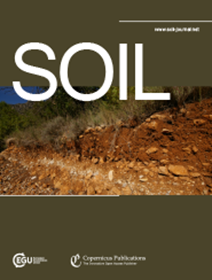Managed black truffle-producing systems have greater soil fungal network complexity and distinct functional roles compared to wild systems
IF 5.8
2区 农林科学
Q1 SOIL SCIENCE
引用次数: 0
Abstract
Abstract. Black truffle (Tuber melanosporum Vittad.), a valued edible fungus, has been thoroughly studied for its ability to modify soil conditions and influence microbial communities in its environment as it dominates the space. While direct associations of black truffle with microbial guilds offer insights into its competitiveness, the role of these interactions in ecosystem functions remain unclear. This study aims to assess the patterns of soil fungal community within the black truffle brûlés across different producing systems (managed vs wild) and seasons (autumn vs spring), to determine the role of T. melanosporum in the structure of the fungal networks, and to identify the contribution of main fungal guilds to soil functioning in these systems. To address this, network analysis was employed to construct the fungal co-occurrence networks in the brûlés of black truffle plantations and wild production areas in forests. Black truffle plantations showed greater fungal homogeneity, network complexity and links compared to forests, indicating enhanced stability, possibly due to reduced plant diversity and uniform conditions, while seasonality did not affect the fungal network structure. Despite its dominance in the brûlés, T. melanosporum was not a hub species in neither truffle-producing systems and exhibited few interactions, mainly with saprotrophs and plant pathogens. Saprotrophic fungi, with partial contributions from ectomycorrhizal and plant pathogen guilds, were the key contributors to carbon and nutrient cycling in both systems. These results improve our understanding of the ecology, biodiversity and functioning of black truffle-dominated soils that could enable more effective management strategies in black truffle plantations.与野生系统相比,管理黑松露生产系统具有更大的土壤真菌网络复杂性和独特的功能作用
摘要。黑松露(Tuber melanosporum Vittad.)是一种有价值的食用菌,由于其在空间中占据主导地位,因此其改变土壤条件和影响环境中微生物群落的能力已被深入研究。虽然黑松露与微生物协会的直接联系提供了对其竞争力的见解,但这些相互作用在生态系统功能中的作用仍不清楚。本研究旨在评估不同生产系统(管理与野生)和季节(秋季与春季)黑松露区域真菌群落模式,确定黑孢霉在真菌网络结构中的作用,并确定这些系统中主要真菌行会对土壤功能的贡献。为解决这一问题,采用网络分析方法,构建了黑松露人工林与森林野生产区 l内真菌共生网络。与森林相比,黑松露人工林表现出更高的真菌同质性、网络复杂性和联系,表明稳定性增强,可能是由于植物多样性减少和条件统一,而季节性不影响真菌网络结构。尽管黑孢T. melanosporum在br lims中占主导地位,但它在两个松露生产系统中都不是中心物种,并且主要与腐养菌和植物病原体发生很少的相互作用。腐养真菌是两个系统中碳和养分循环的主要贡献者,部分贡献来自外生菌根和植物病原体行会。这些结果提高了我们对黑松露主导土壤的生态学、生物多样性和功能的理解,可以为黑松露人工林提供更有效的管理策略。
本文章由计算机程序翻译,如有差异,请以英文原文为准。
求助全文
约1分钟内获得全文
求助全文
来源期刊

Soil
Agricultural and Biological Sciences-Soil Science
CiteScore
10.80
自引率
2.90%
发文量
44
审稿时长
30 weeks
期刊介绍:
SOIL is an international scientific journal dedicated to the publication and discussion of high-quality research in the field of soil system sciences.
SOIL is at the interface between the atmosphere, lithosphere, hydrosphere, and biosphere. SOIL publishes scientific research that contributes to understanding the soil system and its interaction with humans and the entire Earth system. The scope of the journal includes all topics that fall within the study of soil science as a discipline, with an emphasis on studies that integrate soil science with other sciences (hydrology, agronomy, socio-economics, health sciences, atmospheric sciences, etc.).
 求助内容:
求助内容: 应助结果提醒方式:
应助结果提醒方式:


